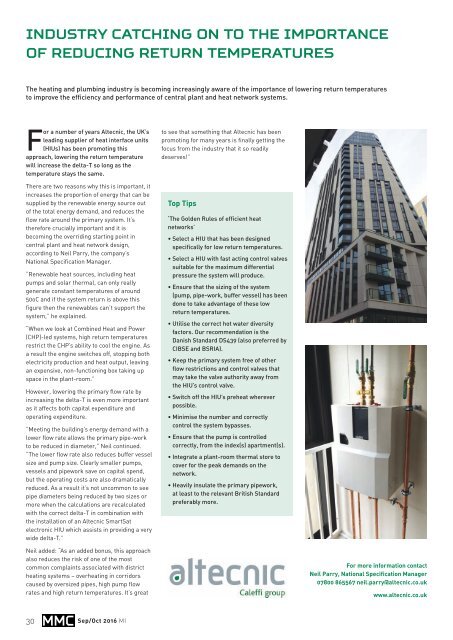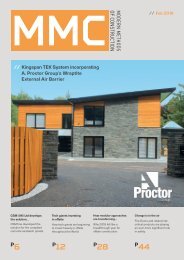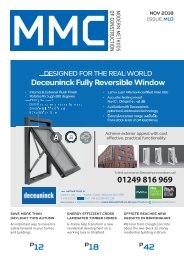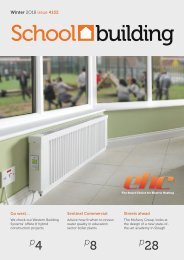Create successful ePaper yourself
Turn your PDF publications into a flip-book with our unique Google optimized e-Paper software.
Industry catching on to the importance<br />
of reducing return temperatures<br />
The heating and plumbing industry is becoming increasingly aware of the importance of lowering return temperatures<br />
to improve the efficiency and performance of central plant and heat network systems.<br />
For a number of years Altecnic, the UK’s<br />
leading supplier of heat interface units<br />
(HIUs) has been promoting this<br />
approach, lowering the return temperature<br />
will increase the delta-T so long as the<br />
temperature stays the same.<br />
There are two reasons why this is important, it<br />
increases the proportion of energy that can be<br />
supplied by the renewable energy source out<br />
of the total energy demand, and reduces the<br />
flow rate around the primary system. It’s<br />
therefore crucially important and it is<br />
becoming the overriding starting point in<br />
central plant and heat network design,<br />
a<strong>cc</strong>ording to Neil Parry, the company’s<br />
National Specification Manager.<br />
“Renewable heat sources, including heat<br />
pumps and solar thermal, can only really<br />
generate constant temperatures of around<br />
50oC and if the system return is above this<br />
figure then the renewables can’t support the<br />
system,” he explained.<br />
“When we look at Combined Heat and Power<br />
(CHP)-led systems, high return temperatures<br />
restrict the CHP’s ability to cool the engine. As<br />
a result the engine switches off, stopping both<br />
electricity production and heat output, leaving<br />
an expensive, non-functioning box taking up<br />
space in the plant-room.”<br />
However, lowering the primary flow rate by<br />
increasing the delta-T is even more important<br />
as it affects both capital expenditure and<br />
operating expenditure.<br />
“Meeting the building’s energy demand with a<br />
lower flow rate allows the primary pipe-work<br />
to be reduced in diameter,” Neil continued.<br />
“The lower flow rate also reduces buffer vessel<br />
size and pump size. Clearly smaller pumps,<br />
vessels and pipework save on capital spend,<br />
but the operating costs are also dramatically<br />
reduced. As a result it’s not uncommon to see<br />
pipe diameters being reduced by two sizes or<br />
more when the calculations are recalculated<br />
with the correct delta-T in combination with<br />
the installation of an Altecnic SmartSat<br />
electronic HIU which assists in providing a very<br />
wide delta-T.”<br />
to see that something that Altecnic has been<br />
promoting for many years is finally getting the<br />
focus from the industry that it so readily<br />
deserves!”<br />
Top Tips<br />
‘The Golden Rules of efficient heat<br />
networks’<br />
• Select a HIU that has been designed<br />
specifically for low return temperatures.<br />
• Select a HIU with fast acting control valves<br />
suitable for the maximum differential<br />
pressure the system will produce.<br />
• Ensure that the sizing of the system<br />
(pump, pipe-work, buffer vessel) has been<br />
done to take advantage of these low<br />
return temperatures.<br />
• Utilise the correct hot water diversity<br />
factors. Our recommendation is the<br />
Danish Standard DS439 (also preferred by<br />
CIBSE and BSRIA).<br />
• Keep the primary system free of other<br />
flow restrictions and control valves that<br />
may take the valve authority away from<br />
the HIU’s control valve.<br />
• Switch off the HIU’s preheat wherever<br />
possible.<br />
• Minimise the number and correctly<br />
control the system bypasses.<br />
• Ensure that the pump is controlled<br />
correctly, from the index(s) apartment(s).<br />
• Integrate a plant-room thermal store to<br />
cover for the peak demands on the<br />
network.<br />
• Heavily insulate the primary pipework,<br />
at least to the relevant British Standard<br />
preferably more.<br />
Neil added: “As an added bonus, this approach<br />
also reduces the risk of one of the most<br />
common complaints associated with district<br />
heating systems – overheating in corridors<br />
caused by oversized pipes, high pump flow<br />
rates and high return temperatures. It’s great<br />
For more information contact<br />
Neil Parry, National Specification Manager<br />
07800 865567 neil.parry@altecnic.co.uk<br />
www.altecnic.co.uk<br />
30 <strong>MMC</strong><br />
Sep/Oct 2016 MI

















